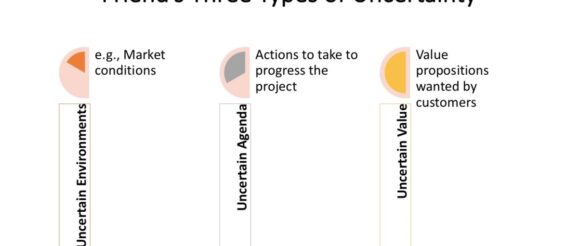What are the three types of uncertainty innovation, and how do they work?

Concept
All innovations face uncertainties, but not all kinds of uncertainties are the same. Entrepreneurs often face three typical uncertainties related to (1) the environment (e.g., places and locations; deciding on the target market and customers), (2) agendas (e.g., plans to manage the project idea; deciding on the business concept, values, offer, growth), and (3) value objectives (e.g., quantitative targets for innovation development).

Background
The three kinds of uncertainty were first argued by Friend and Jessop in their work, ‘ Strategic choice’, in 1969. Friend and Jessop explained uncertainty related to planning and decision-making and identified three classes of uncertainty: Uncertainty Environment UE, Uncertainty Value UV, and Uncertainty related to Agenda UR.
How does it work?
Too much uncertainty makes it hard for entrepreneurs to decide what to do about the target markets and customers, activities to turn up new ideas workable and targets to measure progress made. The following is a brief description of the three kinds of uncertainty related to innovation (Mckeown, 2014)1:
- Uncertain environments: are all about the things you don’t know yet about the situation (e.g., the market). It could be the situation where you try to use your new idea. Or the situation where you want to sell your idea. Either way, the initial answer to uncertain environments is more research. Controlling the uncertain environments involves finding out more about these uncertainties, getting more facts, and understanding how the environment works.
- Uncertain agendas: are about decisions linked to your new idea. Your innovation may highly depend on decisions that you don’t know. It makes sense to find out which decisions you know and don’t know about what, how and when to innovate, when to wait and who (or what to influence). Controlling the uncertain agendas involves taking a broader view, looking at the bigger picture, and connecting the decision chain in your favour.
- Uncertain values: is about not knowing the guiding objectives for your innovation. These might be tastes, preferences or needs that will shape the likely popularity of your new idea in the real world. It might also be the guiding opinions and values inside your group. Controlling uncertain values involves exploring the objectives of your innovation, clarifying what people value, and identifying differences of opinion.
- This post is sourced from my new book- Your Guide To Reach Innovation.
Final note: the book- Your Guide To Reach Innovation, is an actionable guide to innovation from beginning to end. Enjoy reading the book, and I look forward to your reviews.
Author: Munther Al Dawood
Reference:
- Max Mckeown, 2016. The innovation book, Pearson, UK.
